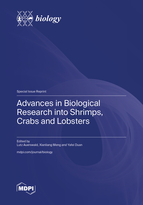Advances in Biological Research into Shrimps, Crabs and Lobsters
A special issue of Biology (ISSN 2079-7737). This special issue belongs to the section "Zoology".
Deadline for manuscript submissions: closed (31 March 2025) | Viewed by 37011
Special Issue Editors
Interests: crustacean; animal sciences; lobsters; fisheries; aquaculture; animal physiology; marine biology
Special Issues, Collections and Topics in MDPI journals
Interests: crustacean; genetics; ecology
Special Issues, Collections and Topics in MDPI journals
Interests: environmental stress; aquatic physiology; intestine microbiota; nutritional immunity; healthy aquaculture
Special Issues, Collections and Topics in MDPI journals
Special Issue Information
Dear Colleagues,
Shrimps, crabs and lobsters form the bulk of the crustacean order Decapoda within the class Malacostraca. There are approximately 15,000 members of this order, which populates diverse habitats around the world. They are often ecological key species and are important, if not essential, for the functioning of marine, freshwater and even some terrestrial food webs and ecosystems. Many of the species represent important fisheries resources and aquaculture species. Some of the species, especially lobsters, are among the most valuable and prized seafood, while others are important sources of marine bio-compounds. Due to their importance, some decapod species have been reasonably thoroughly investigated. However, the sheer number of species and their biodiversity mean that the group, in general, remains under-researched and is far from sufficiently understood. In addition, research often focuses on aquaculture species due to their economic importance and the ease of researching them in captivity. Other, less economically valuable species have received much less studied. There is therefore a mounting need for further studies into shrimps, crabs and lobsters. The aim of this Special Issue therefore is to provide an update on all aspects of biological research into shrimps, crabs and lobsters.
Prof. Dr. Lutz Auerswald
Dr. Xianliang Meng
Dr. Yafei Duan
Guest Editors
Manuscript Submission Information
Manuscripts should be submitted online at www.mdpi.com by registering and logging in to this website. Once you are registered, click here to go to the submission form. Manuscripts can be submitted until the deadline. All submissions that pass pre-check are peer-reviewed. Accepted papers will be published continuously in the journal (as soon as accepted) and will be listed together on the special issue website. Research articles, review articles as well as short communications are invited. For planned papers, a title and short abstract (about 100 words) can be sent to the Editorial Office for announcement on this website.
Submitted manuscripts should not have been published previously, nor be under consideration for publication elsewhere (except conference proceedings papers). All manuscripts are thoroughly refereed through a single-blind peer-review process. A guide for authors and other relevant information for submission of manuscripts is available on the Instructions for Authors page. Biology is an international peer-reviewed open access monthly journal published by MDPI.
Please visit the Instructions for Authors page before submitting a manuscript. The Article Processing Charge (APC) for publication in this open access journal is 2700 CHF (Swiss Francs). Submitted papers should be well formatted and use good English. Authors may use MDPI's English editing service prior to publication or during author revisions.
Keywords
-
Crustacea
- Decapoda
- biology
- fishery
- aquaculture
- ecology
- bio-compounds
- seafood
- physiology
- immunology
- genetics
Benefits of Publishing in a Special Issue
- Ease of navigation: Grouping papers by topic helps scholars navigate broad scope journals more efficiently.
- Greater discoverability: Special Issues support the reach and impact of scientific research. Articles in Special Issues are more discoverable and cited more frequently.
- Expansion of research network: Special Issues facilitate connections among authors, fostering scientific collaborations.
- External promotion: Articles in Special Issues are often promoted through the journal's social media, increasing their visibility.
- Reprint: MDPI Books provides the opportunity to republish successful Special Issues in book format, both online and in print.
Further information on MDPI's Special Issue policies can be found here.









